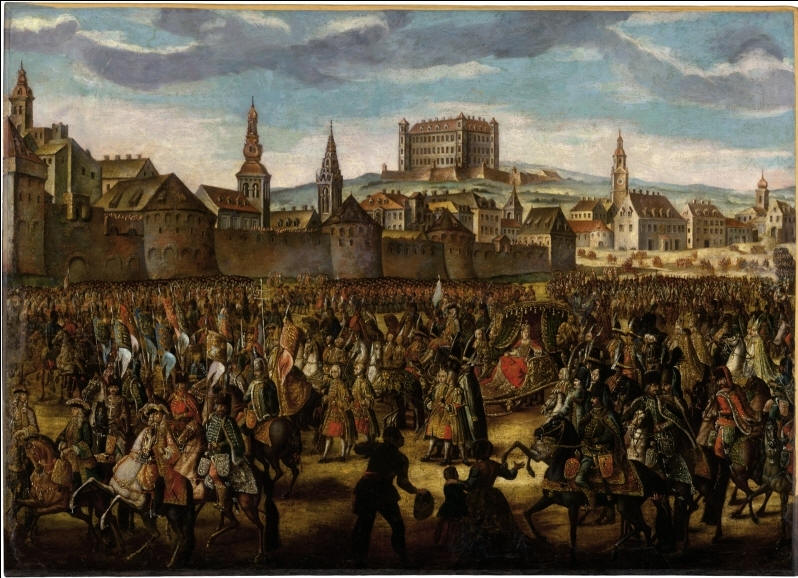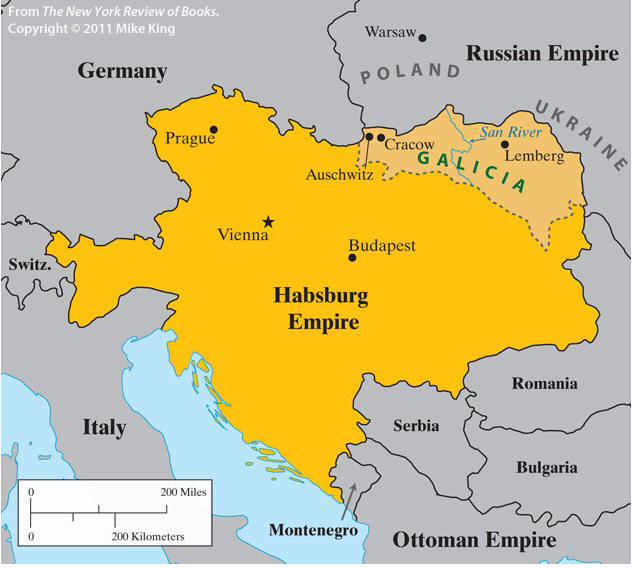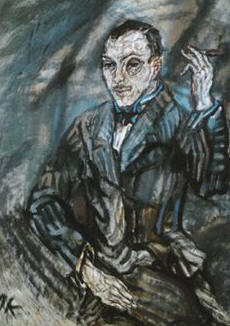


 |
 |
 |
||
| The 1741 coronation ceremony of Empress Maria Theresa in Bratislava. This painting is by Johann Daniel Herz. Maria Theresa became Empress during the lengthy tenure of the Empire's tobacco monopoly by the openly Jewish Baron Moses d'Aguilar, eminent ancestor of many of the English Baruch Lousadas, and whose Portuguese New Christian name had been Diego Lopes Pereira. Pereira had been ennobled by her father and managed to maintain a satisfactory relationship with the Empress despite the fact that Jews in the Empire were subject to many arbitrary rules (see note 2). | The
Austro-Hungarian Empire as it existed just
before the First World War. The loss of most of its Italian territories occurred in the
1800s but the Italian Tyrol, and the Trieste region, was lost after the First World War.
Bratislava is on the Danube between
Vienna and Budapest. It was
the capital of Hungary during the
Austro-Hungarian Empire and is known as
Pressburg in German and Poesing in Hungarian.
Timisoara
is in the western part of Romania not far from
Belgrade. See note 3 for an account of the
evolution of the Empire from 1683 until 1815.
|
Portrait in 1911 by Oskar Kokoschka of Baron Victor Adolf de Dirsztay 1882-1935 who was a patient of Sigmund Freud. He married then divorced Ilona de Losada, one of the twin daughters of the 5th Lousada Duke, according to a grandson. The Dirsztays are discussed here. |
The Austro-Hungarian Empire and
its appearance in our Sephardic ancestry
Exploration of our Sephardic ancestry uncovered surprisingly many ways in which the Austro-Hungarian Empire was involved. These are listed in note 1 below which cites an account of the evolution of Habsburg Jewry thereby giving a helpful background to all these facets of our family history.
In the 1990s Istvan Lousadai Es Dirsztai Letay was an educated multi-lingual hotel porter in Budapest. Peter Lousada made a business trip to Budapest and whilst not actually encountering Istvan thinks his name was noticed by him. Later after Peter retired, Richard de Dirsztay made contact and presented to him the extraordinary and ambitious Dirsztay family tree (ref 31). This tree contains Istvan. Like all traditional family trees it contains vast gaps and errors but also guidance for study (see note 6 below for some use we have made of it). It contains Moritz Baruh (see note 9 below) who probably came to Timisoara after it was extracted from the Ottoman Empire in 1716. It contains Lajos Fischl who became a financial backer of the nationalist Lajos Kossuth but suffered imprisonment under Austrian rule and died soon after in 1855. It shows Erno (grandson of Janos Cole de Leto) who in 1922 being given permission by the Ministry of the Interior to call himself Erno Letay de Losada, and in 1924 was given permission to style himself Nagymeltosagos Losadai es Dirsztai Letay Erno with Losada arms and motto. The porter (see note 7 below) was Erno's son.
Richard's monumental gift to Peter was a reflection of the profound connection the de Dirsztays have with the Baruch Lousadas. It is fair to say that this connection was not fully understood by the de Dirsztays, and indeed we have devoted some effort to interpreting Richard's tree in the light of our parallel work. A fascinating branch of the family is thereby revealed. There is much to understand (and note 8 below reveals a further mystery!).
Notes:
1. The account in ref 303 provides a context for many facets of our story - namely that the father of Simon Barrow of Barbados 1709-1801 was Baruch an Ashkenasi possibly from the Empire (see note 4 below), that the origins of Baron Lyon de Symons were in Bratislava and Vienna (his 'Symons' name prompting us to explore whether he was already related to his son-in-law Simon Barrow of Bath), that Gedalia (brother of Simon Barrow of Barbados) was present in Prague (see note 5), that Baron Moses d'Aguilar was present in Vienna as noted in the caption to the left-hand image above, that probable distant relatives named Fischl and Dirsztay were present in Hungary, and that there was an Italian dimension to the Barrows' ancestral story (see also note 3 below).
2. For the 1744 expulsion of Jews from Prague see ref 66. The order for expulsion was partially revoked a few years later (ref 96 p37). The adoption of German-style surnames in the Empire is discussed in ref 35; the 23 Jul 1787 law requiring German surnames caused the de Dirsztay ancestors to adopt the Fisch/Fischl/Fischer surname. Further examples of arbitrary laws appear in ref 303.
3. We learn from ref 303 that as a result of the War of Polish Succession (1733–38), the Empire's Italian possessions in Lombardy (the Duchies of Milan and Mantua) were consolidated, and in 1737 the Grand Duchy of Tuscany was received in indemnity for the loss of the Duchy of Lorraine. When at the turn of the century the lands of the Venetian Republic were acquired in exchange for Belgium, the Empire finally came to rule over a contiguous northern Italy.
4. The translator of the Hebrew text on the gravestone of Bailah Montefiore suggested that there were indications of an Eastern European origin even Polish. Simon Barrow of Barbados was the probable author of the text. His command of English did not appear to have been great (he marked rather than signed his will) and he probably came to Barbados aged around 50. The Kingdom of Galicia became part of the Empire in 1772 as a result of the First Polish Partition (ref 303).
5. We know this from Simon's will.
6. We have extracted from Richard's tree a summary chart of the descent of Istvan and Richard.
7. Erno became a member of Parliament but he resigned in 1938 on the passing of the Second Jewish Law and unfortunately on 13 Jan 1939 he took his own life on the passing of the Third Jewish Law.
8. Peter Lousada advises that he found in the St Matthias Church in Obuda next to the Hilton Hotel numerous coats of arms high in the eaves inside the church one with a Lousada dove, chevron and azure ground and the name 'Gulielmus Mauritius Janess de Mitiez', which however bears only a hint of a resemblance to 'Moritz Baruh'.
9. Having a Milanese wife, it seems safe to conclude that Moritz Baruh had been in Italy but with a probable birthdate around 1700-10 he would not have gone to Timisoara until around 1740. There were other Italian connections among his descendants, suggesting a continuing link across the Empire which since 1738 (see note 3 above) contained Milan and which had not long before benefited from expansion to the East at the expense of the Ottomans.